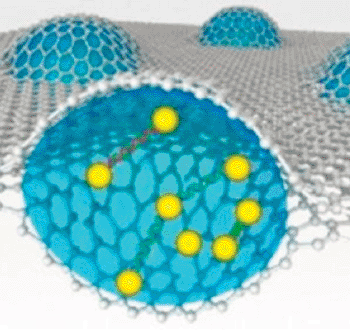3D Dynamic Imaging of Soft Materials Using Transmission Electron Microscopy
By LabMedica International staff writers
Posted on 17 Oct 2013
Through a combination of transmission electron microscopy (TEM) and their own distinct graphene liquid cell, researchers have recorded the three-dimensional (3D) motion of DNA connected to gold nanocrystals. This is the first time TEM has been used for 3D dynamic imaging of so-called “soft materials.”Posted on 17 Oct 2013
A new movie has been produced by researchers at the US Department of Energy (DOE)’s Lawrence Berkeley National Laboratory (Berkeley Lab; Berkeley, CA, USA). “Our demonstration of 3D dynamic imaging goes beyond TEM’s conventional use in seeing flat, dry samples and opens many exciting opportunities for studying the dynamics of biological macromolecular assemblies and artificial nanostructures,” said physicist Dr. Alex Zettl, one of the leaders of this research. “These results were made possible by our novel graphene liquid cell, which can meet the challenges of using TEM to image soft materials.”

Image: Schematic of a graphene liquid cell shows multiple liquid pockets containing single nanoparticles, dimers composed of dsDNA bridges in different lengths, and trimers (Photo courtesy of DOE/Lawrence Berkeley National Laboratory).
Dr. Zettl, who holds joint appointments with Berkeley Lab’s materials sciences division and the University of California (UC) Berkeley’s physics department where he directs the Center of Integrated Nanomechanical Systems, is one of the coauthors of an article published online August 14, 2013, in the journal NANO Letters describing this research.
The term soft materials refers a wide range of substances, including proteins, DNA, and other biologic compounds, plastics, therapeutic drugs, flexible electronics, and certain types of photovoltaics. In spite of their universal presence, soft materials pose many problems because the study of their dynamics at the nanoscale; in particular, biologic systems, has been a challenge. TEM, in which a beam of electrons rather than light is used for illumination and magnification, provides the resolution for such research but can only be used in a high vacuum as molecules in the air disrupt the electron beam. Because liquids evaporate in high vacuum, samples of soft materials, which have been described as “highly viscous fluids,” must be hermetically sealed in special solid containers (called cells) with a viewing window before being imaged with TEM.
In the past, liquid cells featured silicon-based viewing windows whose thickness limited resolution and agitated the natural state of the soft materials. Berkeley Lab’s Dr. Zettl and Dr. Paul Alivisatos, Berkeley Lab director, a coauthor of the study, and their coworkers overcame these hurdles with the development of a liquid cell based on a graphene membrane only a single atom thick. This project was conducted in close cooperation with researchers at the National Center for Electron Microscopy (NCEM), which is located at Berkeley Lab.
“Our graphene liquid cells pushed the spatial resolution of liquid phase TEM imaging to the atomic scale but still focused on growth trajectories of metallic nanocrystals,” said lead author Dr. Qian Chen, a postdoctoral fellow in Dr. Alivisatos’s research group. “Now we’ve adopted the technique to imaging the 3D dynamics of soft materials, starting with double-strand [dsDNA] connected to gold nanocrystals and achieved nanometer resolution.”
To design the cell, two opposing graphene sheets are bonded to one another by their van der Waals attraction. This forms a sealed nanoscale chamber and creates within the chamber a stable aqueous solution pocket approximately 100 nm in height and 1 µm in diameter. The single atom thick graphene membrane of the cells is essentially transparent to the TEM electron beam, minimizing the unwanted loss of imaging electrons and providing superior contrast and resolution compared to silicon-based windows. The aqueous pockets allow for up to two minutes of continuous imaging of soft material samples exposed to a 200 kV imaging electron beam. During this process, soft material samples can freely rotate.
After demonstrating that their graphene liquid cell can seal an aqueous sample solution against a TEM high vacuum, the Berkeley researchers used it to examine the types of gold-dsDNA nanoconjugates that have been widely used as dynamic plasmonic probes. “The presence of double-stranded DNA molecules incorporates the major challenges of studying the dynamics of biological samples with liquid phase TEM,” stated Dr. Alivisatos. “The high-contrast gold nanocrystals facilitate tracking of our specimens.”
The investigators were able to visualize dimers, pairs of gold nanoparticles, fastened by a single piece of dsDNA, and trimers, three gold nanoparticles, connected into a linear configuration by two single pieces of dsDNA. Over time, from a series of 2D projected TEM images captured while the samples were rotating, the researchers were to reconstruct 3D configuration and motions of the samples as they evolved. “This information would be inaccessible with conventional TEM techniques,” Dr. Chen remarked.
Related Links:
Lawrence Berkeley National Laboratory














